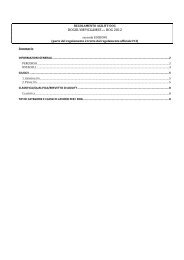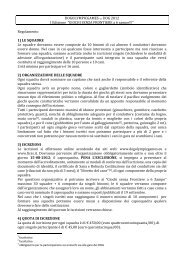DOG AGILITY RULES first edition of DOG OLYMPIC GAMES (Part of ...
DOG AGILITY RULES first edition of DOG OLYMPIC GAMES (Part of ...
DOG AGILITY RULES first edition of DOG OLYMPIC GAMES (Part of ...
Create successful ePaper yourself
Turn your PDF publications into a flip-book with our unique Google optimized e-Paper software.
se<br />
settore nazionale<br />
See-saw<br />
The dog that jumps <strong>of</strong>f the obstacle before passing the pivot point will be penalised with a refusal (5<br />
faults). The see-saw must touch the ground before the dogs alights from the obstacle, otherwise it will<br />
incur 5 faults.<br />
A-frame<br />
The dog that alights from the obstacle before touching the descending ramp with four paws will be<br />
penalised with a refusal (5 faults).<br />
Weaving poles<br />
The <strong>first</strong> pole must be on the left <strong>of</strong> the dog, the second on the right and so on.<br />
Each incorrect entry will be penalised with a refusal (5 faults). For further errors a dog should only be<br />
penalised once, with a fault (5 faults). Back weaving (more than 2 gates) will result in elimination.<br />
The obstacle must be completed correctly before negotiating the next obstacle, failure to do so will<br />
result in elimination on the next obstacle.<br />
Long jump<br />
The units <strong>of</strong> the obstacle are evenly spaced and in ascending order to make a jump that is 0,40 to 1,50 m.<br />
long.<br />
“S” : 40 to 50 cm (2 units), “M” : 70 to 90 cm (3 o 4 units), “L” : 120 to 150 cm (4 to 5 units)<br />
Walking through, running past, jumping in from or out to the side and not traversing the complete obstacle<br />
will be penalised with a refusal (5 faults).<br />
Banking or knocking down one <strong>of</strong> the units, as well as a foot or feet landing between the units will be<br />
penalised with a fault (5 faults). Casual contact will not be faulted.<br />
The dog or handler will not be faulted when they touch or knock down one <strong>of</strong> the marker poles <strong>of</strong> the<br />
long jump, even when this causes one <strong>of</strong> the units to fall down.<br />
Spread jump<br />
Judged in the same way as the single hurdles<br />
Combination jump with two or three hurdles<br />
The hurdles should have a straight approach. The distance between the jumps will be 2 m. in category<br />
Small; 3 m. in category Medium; and 4 m. in category Large. The combination jump should only con sist <strong>of</strong><br />
jumps with a single pole. Each hurdle that is part <strong>of</strong> the combination is judged separately. A fault or a<br />
refusal can be incurred on each element. Should the dog get a refusal on one <strong>of</strong> the elements, then it can<br />
go through the remaining elements <strong>of</strong> the combination without being eliminated, but the whole<br />
combination must be negotiated in the correct order before the dog takes the next obstacle. Taking an<br />
element in the wrong direction is an elimination.<br />
The hurdles should only be set up in a straight line. Combination jumps can be negotiated only once<br />
during a test.<br />
Elimination<br />
Unseemly behaviour towards the judge<br />
Harsh handling <strong>of</strong> the dog<br />
Exceeding the Maximum Course Time<br />
8 CSEN Settore Cin<strong>of</strong>ilia – Responsabile Nazionale Luisella Vitali segreteria@csen-cin<strong>of</strong>ilia.it







